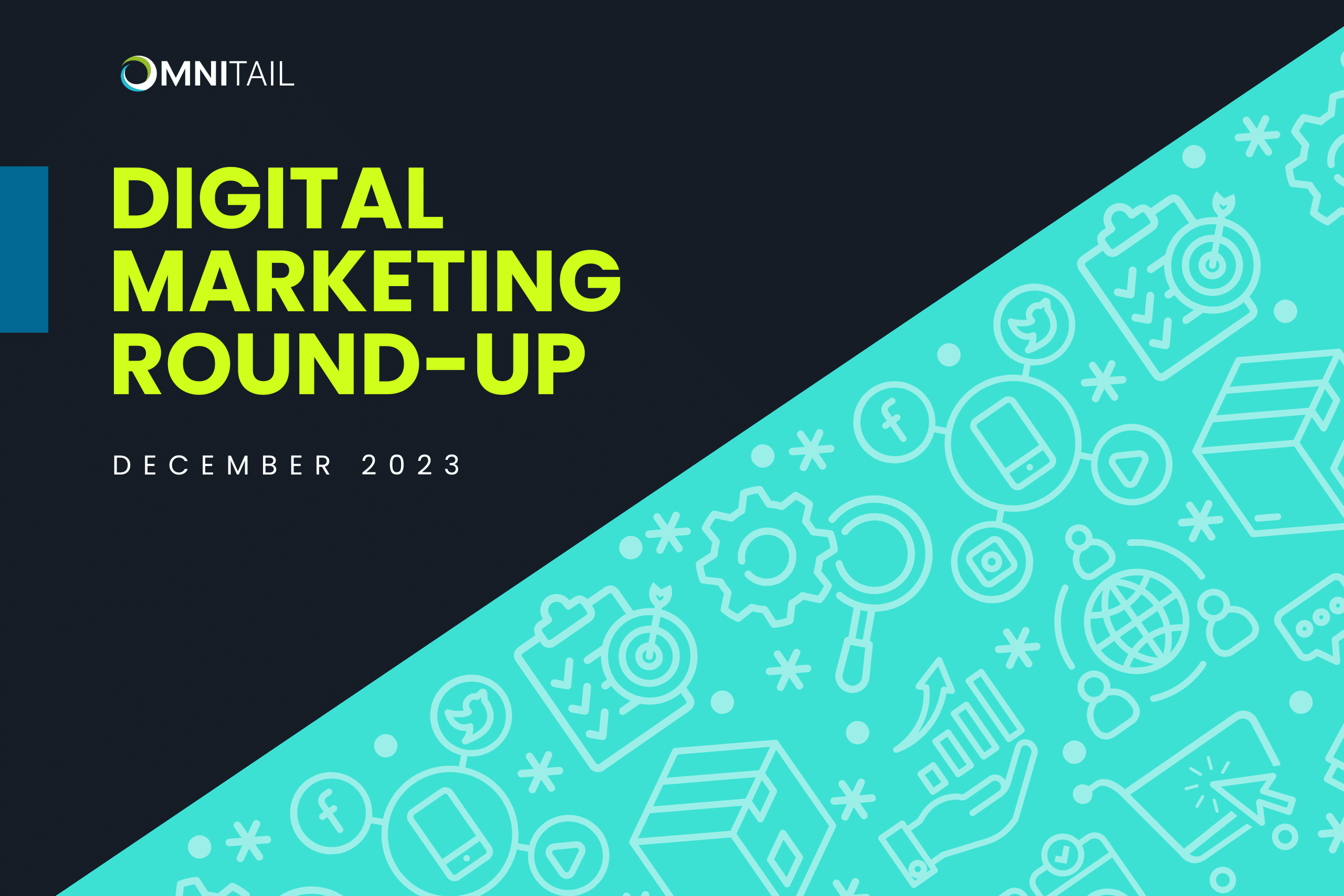Learn about the latest changes, updates, and industry trends in eCommerce marketing
Welcome to our December Digital Marketing News Round-Up! Each month, the Omnitail team discusses some of the top updates in eCommerce and digital marketing. We highlight upcoming changes, industry trends, and more.
This December, we dive into current industry news that caught our attention, like Google’s policy update restrictions on finance ad targeting, LinkedIn giving Collaborative Articles more reach, Google Performance Max new AI features, and more. Here’s our breakdown:
GOOGLE NEWS —
Google Performance Max adding new AI features
New AI features will allow advertisers in the U.S. to use AI tools to generate text and image assets for campaigns in Google Performance Max by early 2024. This update could streamline ad creation processes by allowing advertisers to generate headlines and descriptions for text search ads, and create images from user-inputted prompts.
AI can change how advertisers deliver results, but transparency remains at the forefront. Any images produced with AI in Performance Max will be clearly marked as such.
Why is this important? While AI remains a heated topic of discussion, tools like these actually help marketers quickly create Performance Max ads and assets, especially if they’re running with a lean budget and/or team. Read more about the AI features here.
Google Policy Updates will restrict consumer finance ad targeting
Google’s placing some new restrictions on its personalized ads policy. This update will include consumer finance, meaning that you won’t be able to target audiences in this category based on gender, age, parental status, marital status, or ZIP code.
The update applies to credit or any products and services related to banking, as well as financial planning and management services. Examples include home loans, credit cards, short-term loans, debt management products, and more.
Why is this important? Google’s web crawler is known to make mistakes, so be on the lookout for ads that may incorrectly be hit with this policy violation. Be prepared to appeal once the policy update goes into effect February 2024. Learn more about the update here.
Google Merchant Center Next will soon support rules & supplemental feeds
Google Merchant Center (GMC) Next was unveiled in May. However, if you upgraded to GMC Next and found that rules and feeds were unsupported, you can get those back by reverting to classic mode.
While reverting isn’t ideal, advertisers can use this solution in the interim to restore the functionality that helps optimize Google Shopping ad performance. If you’re an advertiser who hasn’t yet migrated to GMC Next and needs access to rules and supplemental feeds, you’ll want to stick with classic mode for now.
Why does this matter? As an advertiser, finding ways to support customers’ needs is essential. Whether you stick with the classic Merchant Center or choose GMC Next, staying on top of any updates to GMC Next in the upcoming year is important. Learn more about it here.
Google Merchant Center is removing 4 attribution models from conversion tracking
Four rules-based attribution models are being removed from Google Merchant Center. They include first-click, linear, time decay, and position-based.
Come April 2024, if any of your conversion sources are still using these models, they’ll automatically be switched to data-driven attribution. Google is implementing this change after reporting fewer than 3% of Google Ads conversions using these four models.
What does this mean? Even with the sunset of these attribution models, data-driven attribution has proven to be successful. As always, advertisers should stay aware of any upcoming changes to pivot their strategy. Learn more here.
Google adds search themes to Performance Max
Search themes are a new signal powered by Google’s AI that you can use in your Performance Max (PMax) campaigns to allow you to add more information about your customers or your business. Google introduced them as a way to help improve campaign performance.
You can use search themes to fill in knowledge gaps. Per Google, these may work well in instances where you’re launching a new promotion and you want help ramping up your campaigns, when you’ve just launched a new product, etc.
Why does this matter? As an advertiser, you should ensure you have existing keyword coverage for these terms within search campaigns so that PMax does not take preference over search. Read more about search themes here.
LINKEDIN NEWS —
LinkedIn to give Collaborative Articles more reach in search
Collaborative Articles on LinkedIn are a way to unlock community knowledge and advice from those who have real-life experiences. Over the past few months, you might’ve noticed Collaborative Articles on LinkedIn popping up more frequently than before. That’s because LinkedIn gave them more visibility in search.
People outside your network may get exposed to your contribution to these articles, not just those you’re connected with. While this increase in visibility is ideal, there is a problem in the fact that these articles are hit and miss; some are factually correct, while others have misinformation and half-truths spread throughout them. Right now, LinkedIn does not comb through every Collaborative Article with a fine-tooth comb to ensure it’s factually correct, though this is likely to change in the future.
Why is this important? This new reach could give advertisers an advantage and be used as a smart SEO play. LinkedIn Collaborative Articles can help you increase your network and possibly land new leads. LinkedIn is promising better quality for these in the future. We’ll keep you updated as we learn more. Learn more about this update to Collaborative Articles here.
WEBSITE OPTIMIZATION —
Testing ChatGPT-4 for ‘UX audits’ shows an 80% error rate & 14-26% discoverability rate
AI is everywhere and many people are finding out how to fit AI into their everyday workflow to work smarter, not harder. But it may not always hit the mark. Baymard tested ChatGPT-4’s ability to conduct a UX audit by comparing the AI model’s UX suggestions to those from qualified humans conducting a UX audit of the same webpage.
The 12 webpages tested were a mix of product pages, product listings, and checkout pages for various different companies. The results showed ChatGPT-4 had an 80% false-positive error rate and a 20% accuracy rate in the UX suggestions it made. Our take: AI won’t be replacing humans anytime soon.
Why is this important? Though AI can be a helpful tool in some areas of CRO (i.e. standardizing hypothesis writing, summarizing and scoring qualitative research, etc.), it shouldn’t be utilized as a replacement for UX research and analysis. Learn more about the ChatGPT-4 testing here.








